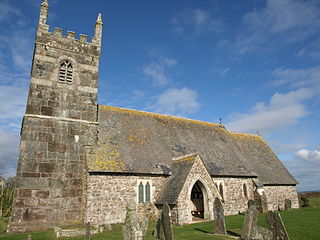
Tresco is the second-biggest island of the Isles of Scilly. It is 297 ha (1.15 sq mi) in area, measuring about 3.5 km (2.2 mi) by 1.75 km (1.09 mi).

St Bartholomew's Church is a parish church of the Church of England Diocese of Truro in Lostwithiel, Cornwall, England, United Kingdom.

Penzance Heliport is located 0.6 NM northeast of Penzance, Cornwall. The heliport hosts scheduled flights to the Isles of Scilly, with a connection to the railway network at Penzance railway station by a special bus service. The original heliport had a single concrete landing pad, which was 30 m × 30 m, inside a 373 m × 45 m grass strip, 08/26.

Augustus John Smith was a British politician and philanthropist who served as Lord Proprietor of the Isles of Scilly for over thirty years from 1834 until his death in 1872, as well as serving as Member of Parliament for Truro from 1857 to 1865. As Lord Proprietor of the Isles of Scilly, he introduced numerous reforms to the islands, including improvements to education, tenancy structures and employment. He built his home on the island of Tresco, and started the Tresco Abbey Gardens. He was succeeded as Lord Proprietor by his nephew, Thomas Smith-Dorrien, after his death in 1872.

Tuckingmill is a village in Cornwall, England, United Kingdom, which is in the civil parish of Camborne. Tucking Mill was the Cornish term for a fulling mill which was where homespun cloth was dipped, cleansed and dressed. There is a mention of a fulling mill in this region as early as 1250. The ecclesiastical parish of Tuckingmill was constituted in 1845, being carved out of a western section of the parish of Illogan and an eastern section of Camborne parish. It covers 1,300 acres (5.3 km2).

The Isles of Scilly is an archipelago off the southwestern tip of Cornwall, England, United Kingdom. One of the islands, St Agnes, is the most southerly point in the British Isles, being over four miles further south than the most southerly point of the British mainland at Lizard Point.

All Saints' Church is a Grade II listed parish church in the Church of England located in Bryher, Isles of Scilly.

St Agnes' Church is a parish church in the Church of England located in St Agnes, Isles of Scilly, UK.

St Mary's Church, St Mary's is a parish church in the Church of England located in Hugh Town, St Mary's, Isles of Scilly, UK. The Church was consecrated on 7 September 1838 and replaced the church at Old Town which was inconvenient for the Hugh Town population and in need of repair.

St Mary's Old Church, St Mary's is a parish church in the Church of England located in Old Town on St Mary's, Isles of Scilly, Cornwall, United Kingdom.

St Grada & Holy Cross Church, Grade is the Church of England parish church of Grade with Ruan, Cornwall. The church is a Grade I listed building, having been added to the listed buildings register on 10 July 1957.

St Maddern's Church is the parish church of Madron, near Penzance in Cornwall and was once the mother church of Morvah and Penzance. It is a Grade I listed building.

St Mary's Church, Penzance is a Grade II* listed parish church in the Church of England in Penzance, Cornwall.

St Ladoca's Church, Ladock, is a Grade I listed parish church in the Church of England Diocese of Truro in Ladock, Cornwall, England, UK.
Presented below is an alphabetical index of articles related to Cornwall:

All Saints’ Church, Tuckingmill is a Grade II listed parish church in the Church of England in Pendarves Street, Tuckingmill, Camborne, Cornwall.

Wesleyan Methodist Church, Hugh Town, Isles of Scilly was a Wesleyan Methodist church in Hugh Town, Isles of Scilly from 1790. It is currently Grade II listed and functions as an office of the Council of the Isles of Scilly.





















